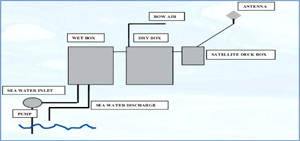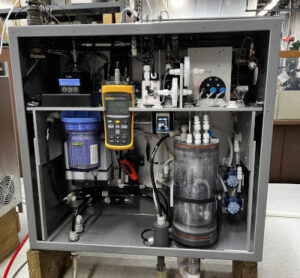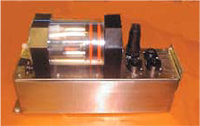Ferry Box
Underway Surface Sea Water pCO2 System
The Model 8060 pCO2 Measuring System is an autonomous analytical system for measuring carbon dioxide in oceanic surface water. The system is modelled after instruments previously built by Craig Neill / University of Bergen. The system may be used on a ship underway or, on a variety of at-sea platforms. The present pCO2 system operates fully automatically and consists of:
- An equilibrator that balances the CO2 in seawater with headspace gas that is analyse
- An infrared analyser to quantify the CO2 concentration in the equilibrator headspace and marine air
- A network of valves and pumps that select, control, and monitor flows of seawater, equilibrator headspace, marine air, and CO2 gas standards
- An on deck enclosure that provides a GPS signal, atmospheric pressure measurement and satellite data transfer
- An integrated notebook computer, computer interface, and software to control valves and pumps and to log data (pressures, temperatures, flows, analyser response, date, time and position).
Overview
The system consists of three enclosures: the dry box, the wet box and the satellite deck box.
The dry box contains a Licor CO2 analyser electrically actuated valves to control the gas flow through the analyser, a gas flow sensor, computer and interface with solid-state relays. There are inlets for up to eight gases. Each inlet has a needle valve for adjusting the flow rate. A three-way solenoid valve directs the gas exiting the analyser towards a vent or towards the equilibrator (when analysing the equilibrator headspace). The dry box utilises an RS485 module and cables to communicate with the other two boxes.
The wet box contains main and vent equilibrating chambers, electronically-actuated valves, pressure gauge and regulating valve, reusable water filter, water flow sensor, barometer, temperature probe, condenser unit, two Nafion drying tubes, and three air pumps. After entering the wet box, seawater passes through the reusable filter, which can be automatically back-flushed with fresh water. An adjustable regulating valve after the filter, sets the water pressure that is delivered to the equilibrators.
The vent equilibrator keeps the CO2 concentration in gas that exchanges with the vent on the main equilibrator close to the concentration in the main headspace. The barometer and temperature probe are attached to the main equilibrator. Seawater drains by gravity out of the wet box.
One of the air pumps in the wet box pulls the headspace gas from the main equilibrator and pushes it through the condenser, a Nafion drying tube and then the CO2 analyser. Another pump pulls air from an exterior inlet provided and located by the user and pushes the air through a condenser. After the condenser, this gas stream is split towards a drying tube and then the CO2 analyser. The reduced-humidity air in the vented chamber is pulled through the drying tubes as counter-flow gas by the third air pump.
The weather resistant satellite deck box contains the modem for Iridium satellite communications, a high-precision barometer, a power supply, and data communication modules. A GPS transducer is attached to deck box and data modules. A ten-conductor cable connects the deck box to the dry box and data modules. A ten conductor cable connects the deck box to the dry box (a 25 metre cable is provided; a cable can be up to 1000 metres long, an extra connector is provided for making a cable for a permanent installation). There is a bulkhead tube fitting for connecting a Gill pressure port to the barometer (pressure port not provided).

Overview
The system consists of three enclosures: the dry box, the wet box and the satellite deck box.
The dry box contains a Licor CO2 analyser (user supplied), electrically actuated valves to control the gas flow through the analyser, a gas flow sensor, computer and interface with solid-state relays. There are inlets for up to eight gases. Each inlet has a needle valve for adjusting the flow rate. A three-way solenoid valve directs the gas exiting the analyser towards a vent or towards the equilibrator (when analysing the equilibrator headspace). The dry box utilises an RS485 module and cables to communicate with the other two boxes.
Options
The following options are available for the 8050 pCO2 Measuring System.
Model 18050-7 Idronaut Multi-parameter Flow Through Sensor Module
The model 18050-7 Idronaut Multi-parameter Flow Through Sensor Module is designed to be integrated into wet box of the pCO2 system. The instrument is used for the measurement of Conductivity, Temperature, Oxygen, pH and Redox. This advanced instrument is the result of 25 years’ experience in the design of high technology water quality probes and offers long term sensor stability for unattended data collection, in either fresh or sea water environments. Data can be stored either internally within the probe or directly onto a PC.
The Model 18050-7 Sensor Module comes complete with two thermometers. The first is fitted near the water sampling port, to accurately measure the temperature of the surface waters, while the second is fitted inside the measuring cell to allow salinity calculations.
The unit is housed in a small (102 x 102 x 318 mm) stainless steel unit with an adjacent parallel transparent sensor chamber which can be easily removed for cleaning. The sample volume of the chamber is only 250ml which enables that the system maintains a fast response time. A pressure sensor inside the cell, acts as an accurate flow meter. For ease of maintenance, the flow through conductivity sensor, features Idronaut’s well accepted large diameter seven ring quartz cell. This does not require black platinum coating and can therefore be easily cleaned in the field, without need for recalibration.
Pump Option
We are able to recommend or supply the proper seawater intake pump that best suits your needs. Please contact us for further information.
Through Hull Intake Water Plumbing Option
This package is a Lloyds approved below water line module, self-contained with all exposed parts either stainless steel or plastic. The unit includes a guillotine shut off valve in case of catastrophic failure. The unit collects water a few inches from the hull through the intake pod assembly. Options include an external sea surface temperature sensor, and a chlorine gas generator to eliminate growth of any microorganisms.
Specifications Model 8050:
Wet Box: Length 61 cm Width 61 cm Depth 25.4 cm
Dry Box: Length 61 cm Width 61 cm Depth 25.4 cm
Satellite Box: Length 35.6cm Width 26.7 cm Depth 20.4 cm
Note: the user must supply the following items:
1. Main water intake pump and plumbing (interfaces to the wet box), see pump and through hull intake plumbing option above.
2. Calibration gases and connecting lines.
3. Co2 analyser (Licor 6262 and 7000 recommended)



